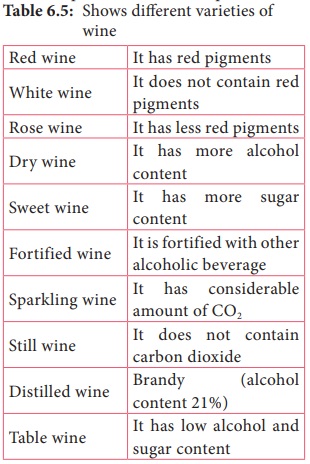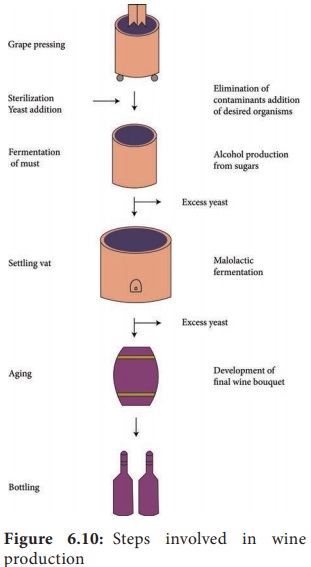Industrial Microbiology - Industrial Production of Wine | 12th Microbiology : Chapter 6 : Industrial Microbiology
Chapter: 12th Microbiology : Chapter 6 : Industrial Microbiology
Industrial Production of Wine
Industrial Production of Wine
An
alcoholic distilled beverage is produced by concentrating alcohol from
fermentation by distillation. Beer or ale is produced by the fermentation of
malted grains. Wine is prepared from grapes belonging to species Vitis vinefera. It is also produced from
other fruits like peach, pear, dandelion and honey. Generally wine contains 16%
of alcohol. Wine production from crushed grapes is called enology. The various
forms of wine are listed below in the table 6.5.

Red wine
is extracted from the skin of red grapes containing red pigment (anthocyanin).
During the preparation of red wine, all the anthocyanin pigments are
solubilized by the extract. Pink wine is
obtained from either pink grapes or red grapes in which fermentation last for
only 12 to 36 hour and only less amount of anthocyanin pigments are solubilized.
White wine is prepared from the white grapes or from the red grapes in which
pigment involved in colouring is removed.
Generally yeasts are the natural microbiota of grapes
Both wild yeast and cultivated yeast are involved in the wine fermentation. Natural yeast is not potable because they do not produce much wine and are less alcohol tolerant and produce undesirable compounds, affecting the quality of the wine.
The
cultivated wine yeast, Saccharomyces ellipsoideus, is used for commercial
production. Figure 6.10 shows steps involved in wine production Table 6.5: Shows
different varieties of wine.

Aqu-aori is the concept that oceans and other bodies of water, might impart unique characteristics on the aging process of submerged wine in water. The ocean provides a unique environ-ment with cold temperatures, constant pressure, and little to no light and con-stant motion.
Steps involved in Wine production
Grapes
are stemmed, cleaned and Crushed
↓
Sodium or
Potassium Meta – bisulphate is added to check the undesirable microorganism
↓
Must
(crushed grapes) is treated with Sulfur dioxide to kill the wild yeasts and
bacteria or sometimes pasteurized to destroy the natural microbiota
↓
Must is
inoculated with Saccharomyces ellipsoideus (2.5%) and selected fermentation is
carried from 50 to 50000 gallons at 20 to 24°C
↓
Oak, cement,
stone glass lined metal are used as fermentor
↓
Temperature
and time required for fermentation White wine: 10–21° C, 7–12 days; Red wine:
24–27°C, 3–5 days
↓
In red
wine production, after three to five days of fermentation, sufficient tanin and
colour is extracted from the pomace and the wine is drawn off for further
fermentation
↓
Racking
improves flavour and aroma,where wine is separated from the sedimentcontaining
yeast cells as precipitate form
↓
The wine
is subjected to aging at lower temperature. Ageing process is typically much
longer for red wine than white wine
↓
Wines are
clarified in a process called fining. Fining is done by filtration through
casein, tannin, diatomaceous earth or bentonite clay, asbestos, membrane
filters or centrifugation
↓
The wine
produced is placed in casks, tank and bottles
Infobits
Saccharomyces is called Brewing Yeasts, or Baker’s Yeast. The
brewing strains can be classified into two groups. The ale strains
(Saccharomyces cerevisiae) and the lager strains (Saccharomyces pastorianus or
Saccharomyces carlsbergenris). The ale strains are top fermenting strains.
Lager strains are hybrid strains of Saccharomycescerevisiae and Saccharomyces
eubayanus and are often referred to as bottom fermenting. (Saccharomyces yeasts
can form symbiotic matrices with bacteria and are used to produce Kombucha,
Kefir, and Ginger beer).
After
wine production, cork should be used for preventing the entry of air into the
bottles. The presence of air allows the growth of vinegar bacteria that convert
the ethanol to acetic acid. The final alcohol content of wine varies depending
upon the sugar content of the grapes, length of the fermentation and type of
strain used.
Related Topics